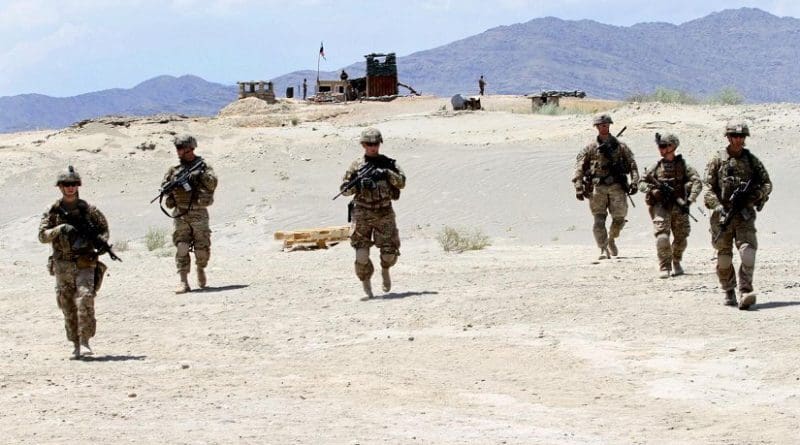Trump’s Afghanistan Strategy – Analysis
By IPCS
By Rana Banerji*
After procrastinating for almost five months, US President Donald Trump chose the symbolically significant platform of Fort Myers, Arlington to announce a shift from a “time-based to a conditions-based” strategy to support the Ashraf Ghani government in Afghanistan. No additional troop numbers have been specified though it is expected that Trump would endorse the consensus figure of roughly around 4,000 more as suggested by his generals on the field, to supplement their “train, assist and advise” role in support of the Afghan National Army (ANA). These numbers could provide more teeth in terms of artillery and air support to drive back the Afghan Taliban from newly gained territories around district centres like Sangin and Lashkargah in Helmand and other areas near Kunduz.
Trump justified the turnaround from his election campaign stance favouring early and complete withdrawal of US troops by indirectly blaming his predecessor, President Obama, for setting a timetable for their withdrawal, which enabled “the enemy to wait us out.” Instead, the expectation would be to move to a position of strength before holding out hope for “a political settlement, someday” when Afghans could themselves deal with this thorny issue of reconciliation.
Trump talked of integrating all elements of US power – military, diplomatic and economic – to help the existing Afghan government to deal with the Taliban. He did qualify, though, that the US’ “commitment was not unlimited,” “not a blank cheque,” and the Afghan government would have to undertake its share of the burden and reform. The US military would “no longer be responsible for building democracies abroad.”
There also appears to be a change of approach towards Pakistan. While acknowledging Pakistan as a valuable US partner in the past and noting that Pakistanis have suffered from the scourge of terrorism, Trump said that the US could no longer remain silent on Pakistan continuing to shelter the same terrorists killing US forces while “we have been paying them billions.” He said that this would “have to change immediately” and it was “time for Pakistan to demonstrate” their willingness to be in the same fight and against the same enemy. Trump added that it was time to “further develop” the strategic partnership with India but expected India “to do more for the economic development of Afghanistan.” He mentioned that the possibility of a confrontation between the two nuclear-armed powers in South Asia remained a US concern.
In effect, Trump has chosen to depend on the advice of his military experts to opt for the ‘containment’ or ‘stabilising’ option in Afghanistan without going into the nitty-gritty of how, eventually, political reconciliation with the Afghan Taliban would be approached. Earlier, speaking at the Stimson Centre in Washington, DC, in April 2017, former Special Envoy and Ambassador to Pakistan, Richard Olson had suggested opening a line to the Taliban through their office in Doha. Taking note of increasing Taliban fragmentation lately, with commanders like Mullah Rahim not taking orders from the anointed leader, Haibatullah Akhund, other Western commentators like Theo Farell and Michael Semple have suggested sending out peace feelers to individual commanders but the current US administration has chosen to be silent in this regard.
The harder line against Pakistan, though expected, has not really been spelt out. Constraints remain obviously due to dependence on the ground lines of communication (GLOC) to send supplies to US and NATO troops in Afghanistan, mainly through Pakistan. The leverage that Pakistan enjoys in this regard was used for bargaining in the past. Simultaneous increase of pressure on Pakistan could lead Islamabad to block transit again. The US risks provoking a blockade of its own forces, though there is some thinking in the Pentagon about exploring alternate routes such as the ‘Lapis Lazuli corridor’ through Central Asia. However, continuing sanctions against Russia and Iran limit US’ manoeuvrability.
Though curtailment of US financial support especially for the Coalition Support Funds (CSF) may hurt, Pakistanis are likely to take in their stride this renewed US pressure ‘to do more’ against elements like the Haqqani network. Pakistan remains obsessed with Indian influence in Afghanistan. Some time ago, in a jointly authored article for The New York Times, Dr Moeed Yusuf, a Pakistani analyst at the United States Institute of Peace (USIP) in Washington, DC, and former US National Security Adviser Stephen Hadley stressed that “the Pakistani security establishment sees the Taliban as a check on Indian activity in Afghanistan and has doubled down on its efforts to counter deepening Afghan-India ties.” They suggested an approach that links efforts to enlist Pakistan’s support in Afghanistan to a strategy aimed at improving India-Pakistan ties. When American analyst Dr C Christine Fair cried foul, stating that “Pakistan’s anxieties are incurable, so stop trying to cure them,” Dr Yusuf took a softer line, asking Pakistan to come to terms with the reality of continuing Indian presence.
Trump’s speech at Arlington did not elaborate on the role of other regional stakeholders in Afghanistan or the need to explore joint approaches to reconciliation with Russia, Iran or China. These powers may continue to play spoilers to prevent lasting peace or stability in Afghanistan.
*Rana Banerji, Member, Governing Council, IPCS, & former Special Secretary, Cabinet Secretariat, Government of India

